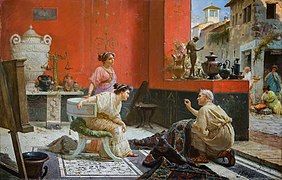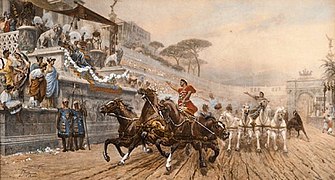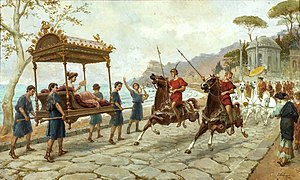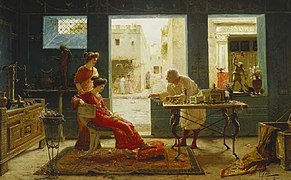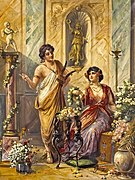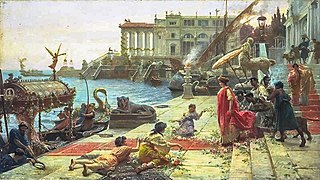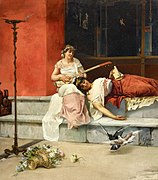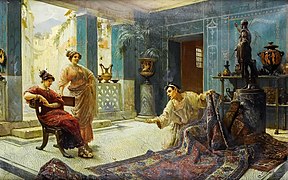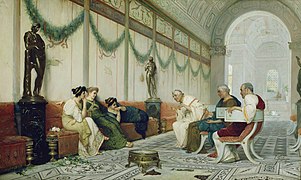
The Circus Maximus is an ancient Roman chariot-racing stadium and mass entertainment venue in Rome, Italy. In the valley between the Aventine and Palatine hills, it was the first and largest stadium in ancient Rome and its later Empire. It measured 621 m (2,037 ft) in length and 118 m (387 ft) in width and could accommodate over 150,000 spectators. In its fully developed form, it became the model for circuses throughout the Roman Empire. The site is now a public park.
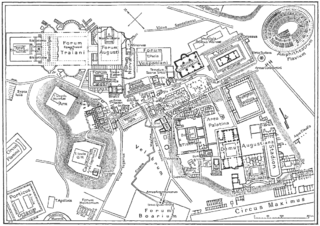
Vicus Tuscus was an ancient street in the city of Rome, running southwest out of the Roman Forum between the Basilica Julia and the Temple of Castor and Pollux towards the Forum Boarium and Circus Maximus via the west side of the Palatine Hill and Velabrum.

Chariot racing was one of the most popular ancient Greek, Roman, and Byzantine sports. Chariot racing was dangerous to both drivers and horses as they often suffered serious injury and even death. These dangers added to the excitement and interest for spectators. Chariot races could also be watched by women, who were banned from watching many other sports. In the ancient Olympic Games, as well as the other Panhellenic Games, the sport was one of the most important equestrian events. Each chariot held a single driver and was usually pulled by four horses.
The Consualia or Consuales Ludi was the name of two ancient Roman festivals in honor of Consus, a tutelary deity of the harvest and stored grain. Consuales Ludi harvest festivals were held on August 21, and again on December 15, in connection with grain storage. The shrine of Consus was underground, it was covered with earth all year and was only uncovered for this one day. Mars, the god of war, as a protector of the harvest, was also honored on this day, as were the Lares, the household gods that individual families held sacred.

The Circus Flaminius was a large, circular area in ancient Rome, located in the southern end of the Campus Martius near the Tiber River. It contained a small race-track used for obscure games, and various other buildings and monuments. It was "built", or sectioned off, by Gaius Flaminius in 221 BC. After Augustus divided the city into 14 administrative regions, the Circus Flaminius gave its name to Regio IX, which encompassed the Circus and all of the Campus Martius west of the Via Lata.
Gaius Appuleius Diocles was a Roman charioteer who became one of the wealthiest athletes in ancient history. He has been described as the highest-paid athlete of all time.

The Roman circus was a large open-air venue used for public events in the ancient Roman Empire. The circuses were similar to the ancient Greek hippodromes, although circuses served varying purposes and differed in design and construction. Along with theatres, amphitheatres, and the much similar but smaller stadiums, circuses were one of the main entertainment sites of the time. Circuses were venues for chariot races, horse races, gladiatorial combat, and performances that commemorated important events of the empire were performed there.

The Roman circus of Mérida is a ruined Roman circus in Mérida, Spain. Used for chariot racing, it was modelled on the Circus Maximus in Rome and other circus buildings throughout the empire. Measuring more than 400 m in length and 30 m of width, it is one of the best preserved examples of the Roman circus. It could house up to 30,000 spectators.

Circus Maximus: Chariot Wars is a 2002 video game set in Ancient Rome featuring chariot racing. Players compete against other chariots, each with a horse and a gladiator, and in death matches where players use their gladiator to fight others to the death. The game takes its name from the Circus Maximus outdoor race track in Rome.
In Greek mythology, the Taraxippus was a presence, variously identified as a ghost or dangerous site, blamed for frightening horses at hippodromes throughout Greece. Some taraxippoi were associated with the Greek hero cults or with Poseidon in his aspect as a god of horses who brought about the death of Hippolytus. Pausanias, the ancient source offering the greatest number of explanations, regards it as an epithet rather than a single entity.
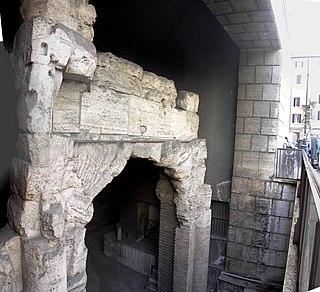
The Stadium of Domitian, also known as the Circus Agonalis, was located to the north of the Campus Martius in Rome, Italy. The Stadium was commissioned around AD 80 by the Emperor Titus Flavius Domitianus as a gift to the people of Rome, and was used mostly for athletic contests.
The Plebeian Games were an ancient Roman religious festival held November 4–17. The games (ludi) included both theatrical performances (ludi scaenici) and athletic competitions for the purpose of entertaining the common people of Rome.

The biga is the two-horse chariot as used in ancient Rome for sport, transportation, and ceremonies. Other animals may replace horses in art and occasionally for actual ceremonies. The term biga is also used by modern scholars for the similar chariots of other Indo-European cultures, particularly the two-horse chariot of the ancient Greeks and Celts. The driver of a biga is a bigarius.

The Taurian Games were games (ludi) held in ancient Rome in honor of the di inferi, the gods of the underworld. They were not part of a regularly scheduled religious festival on the calendar, but were held as expiatory rites religionis causa, occasioned by religious concerns.

In ancient Roman religion, the October Horse was an animal sacrifice to Mars carried out on October 15, coinciding with the end of the agricultural and military campaigning season. The rite took place during one of three horse-racing festivals held in honor of Mars, the others being the two Equirria on February 27 and March 14.
The Circus of Antioch is a hippodrome in Antioch, in present-day Turkey. Used for chariot racing, it was modelled on the Circus Maximus in Rome and other circus buildings throughout the Roman Empire.
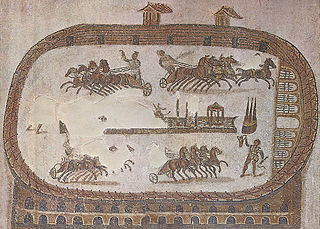
The Circus of Carthage is a Roman circus in Carthage, in present-day Tunisia. Used for chariot racing, it was modeled on the Circus Maximus in Rome and other circus buildings throughout the Roman Empire. Measuring more than 470 m in length and 30 m in width, it could house up to 45,000 spectators, roughly one third of the Circus Maximus.
The hippodrome of Berytus was a circus in the Roman colony of Berytus. It is one of two hippodromes in Beirut.

Circus Maximus is the debut album by Scottish musician Momus, released on 15 January 1986 on Creation Records. It deals primarily with Biblical and Ancient Roman themes, making reference to figures such as Saul, St. Sebastian, Lucretia, and Solomon. The title, Circus Maximus, refers to the ancient Roman chariot racing and entertainment venue of the same name.

Luigi Bazzani, also called Il Bazzanetto, was an Italian painter, illustrator, and watercolorist. He was born November 8, 1836 in Bologna, Italy. Bazzani studied at Bologna's Accademia di Belle Arti then traveled to France, Germany and, eventually, Rome where he settled down in 1861 and began to specialize in genre and landscape subjects as well as set designs for theaters. Many of his paintings featured the remains of the city's monuments from classical antiquity.







